
In biology and genetics, the germline is the population of a multicellular organism's cells that pass on their genetic material to the progeny (offspring). In other words, they are the cells that form the egg, sperm and the fertilised egg. They are usually differentiated to perform this function and segregated in a specific place away from other bodily cells.

The Catalogue of Principal Galaxies (PGC) is an astronomical catalog published in 1989 that lists B1950 and J2000 equatorial coordinates and cross-identifications for 73,197 galaxies. It is based on the Lyon-Meudon Extragalactic Database (LEDA), which was originally started in 1983. 40,932 coordinates (56%) have standard deviations smaller than 10″. A total of 131,601 names from the 38 most common sources are listed. Available mean data for each object are given:
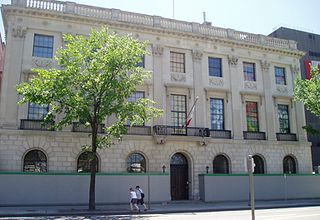
The Portrait Gallery of Canada is a federally-registered not-for-profit corporation that currently has no collection or physical presence.
The ERRs are orphan nuclear receptors, meaning the identity of their endogenous ligand has yet to be unambiguously determined. They are named because of sequence homology with estrogen receptors, but do not appear to bind estrogens or other tested steroid hormones.

Peroxisome proliferator-activated receptor gamma coactivator 1-alpha (PGC-1α) is a protein that in humans is encoded by the PPARGC1A gene. PPARGC1A is also known as human accelerated region 20 (HAR20). It may, therefore, have played a key role in differentiating humans from apes.
P&G Chemicals (PGC) is a division within Procter and Gamble that specializes in the production and distribution of oleochemicals throughout the world.
Marjorie Boyce Kemp was a Scottish stained-glass artist who studied under Margaret Chilton in Glasgow, and eventually set up a studio in Edinburgh with her. This is a list of her major works excluding collaborations with Margaret Chilton, which are listed under List of works by Margaret Chilton. After Chilton's death, Kemp retired from stained-glass work and died in Edinburgh on the 20 April 1975.

NGC 52 is an edge-on spiral galaxy in the constellation Pegasus. It was discovered on September 18, 1784 by William Herschel. He described it as "very faint, small, extended."
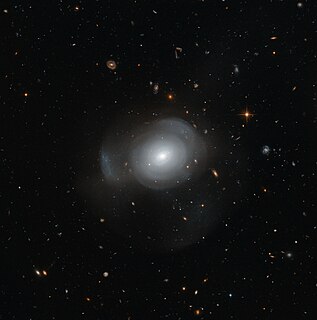
PGC 6240, also known as AM 0139-655 or the White Rose Galaxy, is a very large and old galaxy in the southern constellation of Hydrus, about 345 million light years away from Earth.
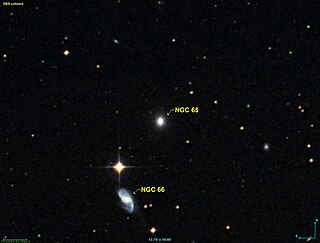
NGC 65 is a lenticular galaxy in the constellation Cetus. Its apparent magnitude is 13.4. It was first discovered in 1886, and is also known as PGC 1229.
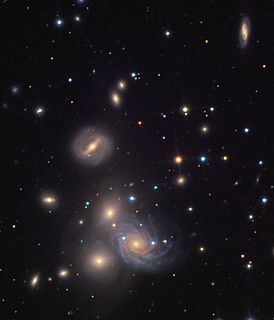
NGC 67 is an elliptical galaxy located in the constellation Andromeda that was discovered on October 7, 1855 by R. J. Mitchell, who described it as "extremely faint, very small, round". The galaxy belongs to the NGC 68 group, which also contains the galaxies NGC 68, NGC 69, NGC 70, NGC 71, NGC 72, and possibly NGC 74.

NGC 131 is a spiral galaxy that was discovered on September 25, 1834, by John Herschel. This galaxy belongs in the NGC 134 group of galaxies: NGC 115, NGC 148, NGC 150, PGC 2000, IC 1555, and PGC 2044.
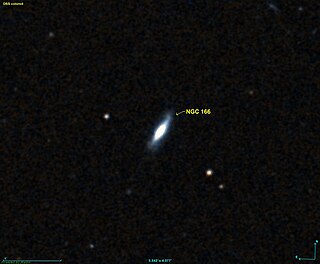
NGC 166 is a spiral galaxy located around 2.6 million light-years away in the constellation Cetus, with an apparent magnitude of 15.18. It was discovered by Francis Preserved Leavenworth in 1886.
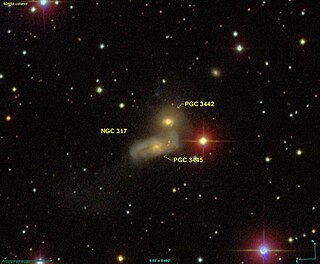
NGC 317 is a pair of interacting galaxies, consisting of a lenticular galaxy and a spiral galaxy, in the constellation Andromeda. It was discovered on October 1, 1885 by Lewis Swift.
NGC 331 is a barred spiral galaxy in the constellation Cetus. It was discovered in 1886 by Francis Leavenworth. It was described by Dreyer as "extremely faint, very small, round, a little brighter middle, 12th magnitude star 3 arcmin northeast." There are two candidates as to which object is NGC 331: PGC 2759 or PGC 3406, with the former being a much more likely candidate than the latter.
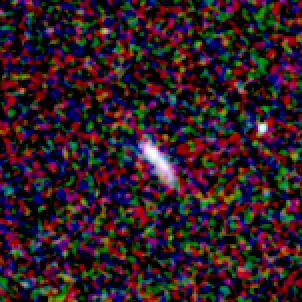
NGC 336 is a spiral galaxy in the constellation Cetus. It was discovered on October 31, 1885 by Francis Leavenworth. It was described by Dreyer as "very faint, small, round, suddenly brighter middle." It is also known as PGC 3470. Despite this, sometimes it is mistakenly identified as PGC 3526.

NGC 414 is a pair of lenticular galaxies of types S0 and E/S0, respectively, located in the constellation Pisces. It was discovered on October 22, 1867 by Herman Schultz. It was described by Dreyer as "very faint, small, irregularly round, much brighter middle, II 220 to the northwest.", with II 220 being NGC 410.
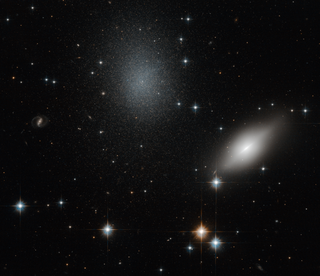
NGC 5011 is an elliptical galaxy in the constellation of Centaurus. It was discovered on 3 June 1834 by John Herschel. It was described as "pretty bright, considerably small, round, among 4 stars" by John Louis Emil Dreyer, the compiler of the New General Catalogue.

The Philippine Genome Center (PGC) is a multi-disciplinary research facility in Quezon City, Metro Manila, Philippines which specializes in genomics.

NGC 527, also occasionally referred to as PGC 5128 or PGC 5141, is a lenticular galaxy located approximately 259 million light-years from the Solar System in the constellation Sculptor. It was discovered on 1 September 1834 by astronomer John Herschel.
![]() 02h 53m 35.851s, −83° 08′ 31.85″
02h 53m 35.851s, −83° 08′ 31.85″ 















